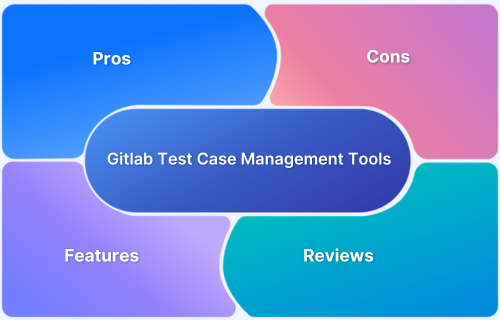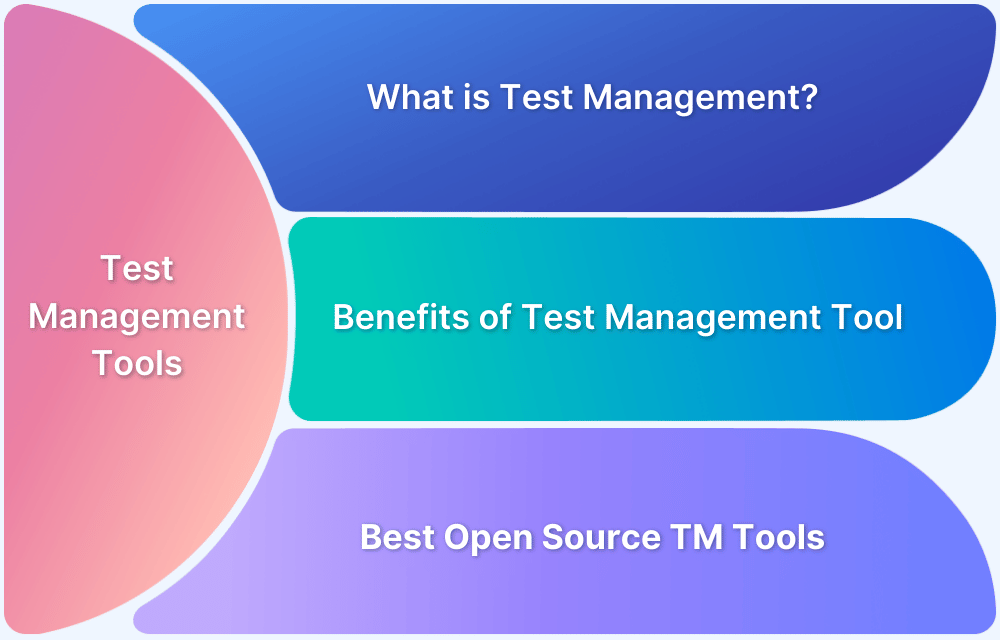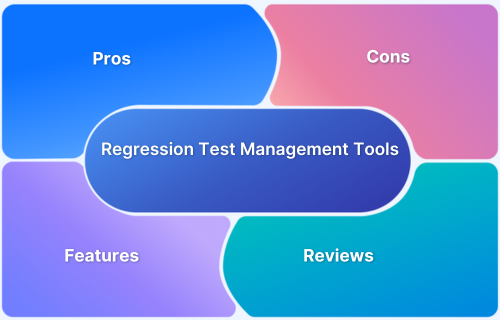DevOps test management tools streamline testing in CI/CD pipelines, enhancing collaboration, automation, and speed. These tools are essential for fast-paced teams aiming to deliver high-quality software quickly.
Overview
Top Test Management Tools for DevOps Teams in 2025
- BrowserStack Test Management: AI-powered test generation and low-code automation with extensive CI/CD support.
- TestRail: Robust test case tracking with detailed reports and Jira integration.
- PractiTest: End-to-end traceability with customizable dashboards and automation hooks.
- TestCollab: Simple planning, collaborative execution, and Jira/Slack integrations.
- Xray for Jira: Native Jira test management with CI/CD pipeline integration.
- QAComplete: Flexible workflows with hybrid test support and defect linking.
- Kualitee: User-friendly test and defect management with API triggers, free plan available.
- SmartBear Test Management: Enterprise-scale test management with automation and analytics.
- Azure DevOps Test Plans: Integrated Azure manual/exploratory testing with pipeline automation.
- Zephyr for Jira: Jira-native test authoring and automation syncing with Agile focus.
This article gives a detailed overview of the popular test management tools for DevOps teams, their key features, and best practices for using them.
What are DevOps Test Management Tools?
DevOps test management tools integrate testing seamlessly into the continuous delivery pipeline. These tools help teams manage test cases, track defects, and ensure continuous testing throughout the development cycle. They automate many testing tasks, improving speed and agility.
Key features of DevOps test management tools include:
- Test Case Management: Organize and execute tests efficiently.
- CI/CD Integration: Automate testing within continuous integration and deployment pipelines.
- Automation Support: Increase test coverage through automation.
- Collaboration Features: Improve teamwork across development and operations teams.
Why do DevOps Teams Need Test Management Tools?
DevOps teams need test management tools to maintain speed and quality in fast-paced development cycles. These tools help automate tests, track progress, and ensure timely feedback. Without them, teams may face inefficiencies, undetected defects, and delays.
Here’s why DevOps teams benefit from test management tools:
- Continuous Integration: Ensure testing runs smoothly within CI/CD pipelines.
- Real-Time Collaboration: Enable quick issue resolution with cross-team communication.
- Increased Efficiency: Automate repetitive tasks, reducing manual effort.
- Enhanced Visibility: Access real-time insights into test progress and results.
How Test Management Tools Accelerate DevOps Workflows
Test management tools speed up DevOps workflows by automating tests, providing feedback, and integrating into the CI/CD pipeline. They ensure continuous quality checks without slowing down development cycles.
Here’s how they help:
- Automated Test Execution: Automate tests to save time and reduce errors.
- Real-Time Feedback: Get immediate insights on code quality to address issues quickly.
- CI/CD Integration: Seamlessly integrate tests into deployment pipelines.
- Collaboration: Improve teamwork and transparency across development and operations.
Key Differences Between Traditional Test Management and DevOps Test Management
DevOps test management tools integrate testing into the CI/CD pipeline for faster feedback and seamless collaboration. Traditional test management, however, works in isolated phases, resulting in slower feedback and disconnected workflows.
| Aspect | Traditional Test Management | DevOps Test Management |
| Integration with Development | Often operates separately from development processes. | Seamlessly integrates with CI/CD pipelines and development workflows. |
| Automation | Limited automation, mainly manual testing processes. | High level of automation, particularly with regression and functional tests. |
| Testing Frequency | Testing is done in phases after development or at the end. | Continuous testing throughout the development cycle. |
| Collaboration | Typically, testers work in silos, with less communication with development teams. | Real-time collaboration between developers, testers, and operations. |
| Feedback Cycle | Feedback is slower, often coming after the development phase. | Immediate feedback after each code change or commit. |
| Test Execution | Manual execution of tests, often done manually by testers. | Automated execution within the CI/CD pipeline for faster results. |
| Scalability | Less scalable as teams grow and projects become more complex. | Highly scalable with distributed testing capabilities and cloud support. |
| Tool Integration | Limited integrations with other tools. | Deep integration with DevOps tools like Jenkins, GitLab, and Azure DevOps. |
Key Features of Test Management Tools for DevOps Teams
Test management tools for DevOps teams are designed to optimize continuous integration and deployment (CI/CD) workflows, enabling efficient management of test cases, defects, and reporting in a collaborative, automated environment.
Key features include:
- CI/CD Pipeline Integration: Seamlessly integrates with tools like Jenkins, GitLab, and Azure DevOps to automate testing at every pipeline stage.
- Real-Time Test Reporting: Instant feedback through real-time dashboards and detailed reports, allowing quick issue identification and resolution.
- Test Automation Support: Automates repetitive tests (e.g., regression, smoke tests) with support for tools like Selenium and Cypress, reducing manual efforts.
- Collaboration: Enhances teamwork by allowing real-time sharing of test cases, issues, and updates among developers, testers, and operations teams.
- Version Control & Traceability: Tracks test case changes and links them to requirements, user stories, and defects for better traceability.
- Cloud-Native Architecture: Offers flexibility and scalability, enabling remote access for teams across different locations.
- Customizable Workflows: Adapts to unique DevOps processes, ensuring seamless test execution and strategy alignment.
- Integration with Test Automation Frameworks: Supports automation tools like Selenium, Appium, and TestNG, improving test efficiency within DevOps workflows.
- Advanced Analytics: Provides insights into test coverage, failure rates, and trends, helping teams optimize test strategies.
Top Test Management Tools for DevOps Teams in 2025
The top test management tools for DevOps teams in 2025 integrate with CI/CD pipelines, offering automation and real-time feedback. These tools enhance collaboration, accelerate testing, and improve code quality.
1. BrowserStack Test Management
BrowserStack Test Management is a comprehensive AI-powered platform that revolutionizes testing workflows from creation through execution to validation.
It enables teams to achieve 90% faster test authoring and 50% improved coverage through intelligent automation and advanced analytics.
Key Features:
- AI-driven test case generation from requirements, PRDs, and user stories with intelligent enhancement suggestions
- Test deduplication agent that identifies and recommends removal of duplicate test cases across repositories
- Low-code automated test conversion to transform manual cases into automated tests without deep coding expertise
- Advanced analytics with customizable dashboards, real-time insights, and AI-powered failure analysis that’s 95% faster
- Unified platform supporting 50+ automation frameworks and CI/CD tools with seamless Jira integration
Use Cases:
- Accelerating regression testing with AI-generated comprehensive test suites for rapid release cycles
- Centralizing test management across distributed teams with real-time collaboration and progress tracking
- Implementing quality gates for automated deployment validation and blocking faulty code merges
Pros:
- Industry-leading AI capabilities deliver fourfold increase in test coverage and productivity
- Comprehensive free plan with unlimited test cases and robust integrations suitable for teams of all sizes
Try BrowserStack Test Management
2. PractiTest
PractiTest is a full-featured SaaS test management platform focusing on traceability, visibility, and seamless collaboration. DevOps and QA teams benefit from customizable dashboards and robust integrations.
Key Features:
- End-to-end traceability from requirements to defects
- Real-time customizable dashboards
- Actionable automation integrations
- Hierarchical test organization
- Built-in issue and requirement management
Use Cases:
- Mapping business requirements to releases and tests
- Sharing outcome analytics with external stakeholders
- Coordinated manual/automated runs for regulated products
Pros:
- Intuitive interface with fast setup
- Excellent traceability for audits and compliance
Cons:
- Lacks some niche advanced testing types
- Customization requires initial configuration effort
3. TestRail
TestRail is a structured test management system widely used for organizing, tracking, and reporting on test cases, plans, and runs. Designed for scalable manual and exploratory testing, it offers integration with test automation frameworks and CI/CD.
Key Features:
- Centralized test case repository with foldering
- Extensive reporting and real-time dashboards
- Native Jira, CI, and automation tool integrations
- Advanced permissioning and reusable steps
- Enterprise/server deployment options
Use Cases:
- Coordinated manual test execution in large QA teams
- Historical test data analysis for compliance audits
- Sprint-based tracking with DevOps automation sync
Pros:
- Comprehensive case and plan management
- Flexible reporting and wide integration support
Cons:
- No AI-driven features, more manual overhead
- Can be expensive for large user counts
4. TestCollab
TestCollab is a streamlined collaborative test management tool designed to make planning, running, and analyzing tests intuitive for distributed QA/DevOps teams. It supports workflows from simple to advanced project needs.
Key Features:
- Hierarchical test planning and runs
- Jira and other tool integrations
- Visual result analytics
- REST API for DevOps workflows
- Custom statuses and notifications
Use Cases:
- Simplifying manual test cycles for SaaS startups
- Cross-functional QA-dev collaboration in sprints
- Tracking execution status for distributed teams
Pros:
- Simple, user-friendly interface
- Solid analytics for quick insights
Cons:
- Fewer advanced automation integrations
- Reporting less customizable than some competitors
Must Read:17 Best Test Management Tools For Jira
5. Xray for Jira
Xray for Jira provides native test management inside Jira, enabling test case creation, requirements mapping, execution tracking, and seamless automation, all within a unified Agile workflow.
Key Features:
- Native Jira issue-type test management
- Detailed traceability: requirements, defects, environments
- Automated/manual test planning
- Built-in REST API and reporting
- Out-of-the-box CI/CD/automation integration
Use Cases:
- Integrating test activities in Jira-based Agile teams
- Executing and reporting cross-browser automation runs
- Managing compliance evidence directly in project tracking
Pros:
- No context-switching, full Jira native feel
- Strong reporting and requirement traceability
Cons:
- Feature depth depends on Jira hosting tier
- Large repo performance can be variable
Learn More:Xray Alternatives for Test Management
6. QAComplete
QAComplete is a flexible test management solution for designing, executing, and reporting on tests and defects, with workflow automation and deep integration options, suited to both Agile and traditional QA teams.
Key Features:
- Customizable test suites and folder structure
- Automated/manual run support
- Advanced workflow and user role controls
- Built-in defect and requirements linking
- Reporting and dashboards
Use Cases:
- Coordinating manual, exploratory, or automated tests
- Managing multi-release projects with detailed reporting
- Complete defect lifecycle management
Pros:
- Customizable workflows and role controls
- Good integration with CI and automation platforms
Cons:
- On-premise features require advanced configuration
- UI may feel dated compared to some newer tools
7. Kualitee
Kualitee delivers flexible test and defect management for both startups and enterprises, with dashboards, automation hooks, and rich reporting via a modern, user-friendly cloud or on-premise offering.
Key Features:
- Comprehensive test case and defect management
- Requirements traceability
- Real-time dashboards and analytics
- Integration with Jira, Git, automation tools
- Automation trigger support via API
Use Cases:
- Defect and regression management for product teams
- Automating test triggers on deployment
- Reporting to management on test execution
Pros:
- Offers both free and premium plans
- User-friendly interface with rich analytics
Cons:
- Limited API depth for complex automation
- Some integrations require manual setup
8. SmartBear Test Management
SmartBear’s test management platform (including Zephyr Enterprise) supports enterprise-scale QA and DevOps with robust planning, automation, analytics, and reporting capabilities for highly regulated, large-scale projects.
Key Features:
- Centralized manual and automated test management
- Advanced scheduling and tracking
- Live analytics and reporting dashboards
- CI/CD tool integrations
- Multi-project and multi-team support
Use Cases:
- Large-scale regression and acceptance testing
- Real-time test reporting across multiple teams
- Compliance-tracked test execution in regulated industries
Pros:
- Enterprise-grade scalability and analytics
- Broad toolchain integration including automation
Cons:
- Enterprise price point
- Advanced features may require extra configuration
9, Azure DevOps Test Plans
Azure DevOps Test Plans offers tightly integrated test management within the Microsoft DevOps ecosystem, supporting manual, exploratory, and automated testing with rich traceability and reporting.
Key Features:
- Manual and exploratory test case tracking
- End-to-end traceability in Azure Boards
- Automated pipeline integration
- Advanced bug and defect capture tools
- Real-time dashboards and web-based access
Use Cases:
- In-line test case management for Azure-centric dev teams
- Integrated reporting and traceability for compliance
- Automating test triggers in CI/CD workflows
Pros:
- Best for organizations on Azure DevOps stack
- Visual reporting and strong traceability
Cons:
- Full value requires other Azure DevOps modules
- Steeper learning curve for non-Microsoft users
Also Read: 25 Best Free Test Management Tools for 2025
10. Zephyr for Jira
Zephyr for Jira brings comprehensive test management directly to Jira, supporting seamless planning, execution, and reporting for both manual and automated QA in Agile environments.
Key Features:
- Test authoring, planning, and execution in Jira
- Automation results sync and dashboards
- Requirements mapping and coverage
- Full REST API and CI/CD hooks
- Multi-project and release management
Use Cases:
- Bridging manual and automated QA in Jira sprints
- Test analytics for release readiness
- Integrating QA metrics into Agile ceremonies
Pros:
- Native Jira workflow integration
- Real-time test coverage and status views
Cons:
- Feature access differs by plan and hosting (Cloud/Data Center)
- Can slow down Jira instance under heavy load
Learn More:Zephyr Alternatives for Test Management
Comparative Analysis of Test Management Tools for DevOps
Here is a quick overview of the comparative analysis of top test management tools for DevOps.
| Tool Name | Key Features | Pros | Cons |
| BrowserStack Test Management | End-to-end AI-powered workflow: test case generation, deduplication, auto-conversion, customizable dashboards, 50+ integrations | Free unlimited plan, intuitive for teams of any size | Some advanced configurations are available in the paid plan |
| TestRail | Test repository, foldering, dashboards, Jira/automation integration, reusables, cloud/on-prem options | Solid manual planning, broad integrations | No AI creation/maintenance, costs escalate with scale |
| PractiTest | Traceability, automation hooks, dashboards, built-in issue mgmt, hierarchy organization | User-friendly, strong compliance traceability | Less depth in certain test types, initial config needed |
| TestCollab | Hierarchical runs, analytic reports, easy Jira/Slack integration, API, custom statuses | Fast setup, visual analytics | Limited automations, less flexibility in reporting |
| Xray for Jira | Jira-native: requirements mapping, defect linking, auto/manual tracking, reporting, CI/CD integration | Embedded in Jira, detailed traceability | Depth/features limited by Jira plan, variable big repo speed |
| QAComplete | Custom folders/suites, hybrid test support, workflow/role config, built-in defect reqs, dashboards | Flexible, supports diverse workflows | Complex on-prem setup, interface feels older |
| Kualitee | Test/defect mgmt, real-time dashboards, API/automation hooks, requirements linking, free plan available | Free tier available, easy learning curve | Advanced API, automation take effort, manual integration |
| SmartBear Test Management | Enterprise Test Management, manual/automation support, advanced dashboards, project scaling, CI/CD with Zephyr | Scalable, integrates automation seamlessly | Premium pricing, setup complexity for full feature access |
| Azure DevOps Test Plans | Exploratory/manual tracking, Azure Boards traceability, CI/CD pipeline integration, bug tools, dashboards | Tight with Microsoft stack, visual analytics | Needs Azure suite adoption, more complex for outsiders |
| Zephyr for Jira | Jira-driven test author/plan/exec, automation sync, REST API, CI/CD support, release handling | Strong native Jira workflow integration | Tiered features by hosting, can slow Jira with high volume |
Best Practices for Implementing Test Management Tools in DevOps
To successfully implement test management tools in a DevOps environment, consider the following best practices:
- Align with DevOps Processes: Choose tools that integrate smoothly with your existing CI/CD pipeline. Ensure the tool supports automated testing and provides real-time feedback, crucial for maintaining speed and quality.
- Train Teams: Equip developers, testers, and operations teams with the necessary training to maximize the effectiveness of the tool. This ensures seamless adoption and proper usage across departments.
- Automate Where Possible: Automate repetitive tasks like regression and smoke tests to improve efficiency and reduce human errors.
- Continuous Monitoring: Regularly monitor the performance and adoption of the test management tool. Use insights and analytics to refine test strategies and optimize test coverage.
- Foster Collaboration: Promote collaboration between development, testing, and operations teams through shared dashboards and integrated communication tools, improving transparency and faster issue resolution.
Future Trends in DevOps Test Management
DevOps test management is evolving with key trends shaping its future:
- AI and Machine Learning: Automating test creation and failure prediction, improving efficiency.
- Cloud-Native Solutions: Scalable, flexible cloud tools for remote and distributed teams.
- Generative AI: Dynamic test script creation and automation of test maintenance.
- Shift-Left Testing: Early detection of defects for quicker issue resolution.
- Enhanced Analytics: Deeper insights to optimize test effectiveness and reduce risks.
Conclusion
In 2025, DevOps test management tools like BrowserStack Test Management are driving efficiency with seamless CI/CD integration, AI-powered testing, and real-time feedback.
By leveraging these tools, DevOps teams can accelerate testing, enhance collaboration, and maintain high-quality software delivery, staying ahead of emerging trends like AI and cloud-native solutions.








